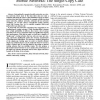365 search results - page 17 / 73 » Collaboration Improves the Connectivity of Wireless Networks |
SECON
2008
IEEE
14 years 1 months ago
2008
IEEE
— In an effort to better understand connectivity and capacity in wireless networks, the log-normal shadowing radio propagation model is used to capture radio irregularities and o...
PERCOM
2004
ACM
14 years 7 months ago
2004
ACM
We present the Cooperative Location-sensing system (CLS), an adaptive location-sensing system that enables devices to estimate their position in a self-organizing manner without t...
CSREASAM
2006
13 years 8 months ago
2006
A mobile ad hoc network is a self-organizing network that relies on the cooperation of participating nodes in order to function properly. In this network, mobile users arrive withi...
MOBICOM
2006
ACM
14 years 1 months ago
2006
ACM
In this paper, we consider the problem of mitigating interference and improving network capacity in wireless mesh networks from the angle of temporal-spatial diversity. In a nutsh...
TON
2008
13 years 7 months ago
2008
Abstract--Intermittently connected mobile networks are wireless networks where most of the time there does not exist a complete path from the source to the destination. There are m...

